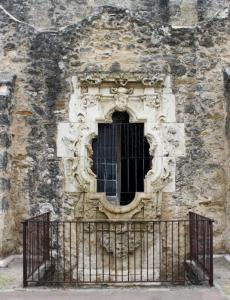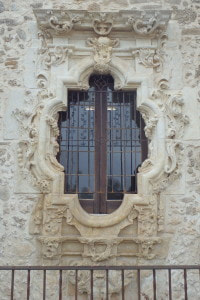The Rose Window of San Jose
MISSION SAN JOSE DE AGUAYO of San Antonio, Texas, called the Queen of all Missions, has the most photographed window in the world, “THE ROSE WINDOW”. It is a “poem of perfect beauty”. The Rose Window like everything of beauty, ever awe-inspiring because of the intricate carving, is considered by connoisseurs to be the finest single original piece of Spanish-Colonial ornamentation existing in America.
Famous throughout the civilized world is the renowned ROSE WINDOW OF SAN JOSE MISSION, admired yearly by thousands of visitors from all over the United States and many foreign countries.
To this day, the delicacy of the artistic carving and the creative originality of its design have not been surpassed. When one considers the date of its conception, early in the 18th century (some say about 1775), it becomes a truly remarkable undertaking.
One of the most interesting and realistic of the legends that cling to the romantic old Mission is that pertaining to the Rose Window.
A handsome young Spaniard came to the New World to gain fortune and fame so he may make himself worthy of the beautiful Rosa, the girl who had bade him farewell and was now waiting word from him.
She lived in a little Village. As soon as he had made a suitable fortune, she was to come to “NEW SPAIN” and meet him at SAN JOSE MISSION.
Pedro Huizar was a talented sculptor. With chisel and hammer he was engaged by a Missionary to carve a window for the Church and to put into it all the beauty and splendor of his art. The design must be of a religious nature in order to be fitting for the Church. It is said that his love for Rosa inspired him to pour into the window his love and passion. Into this delicate and gracefully carved window he would put nothing but roses, but alas, Rosa who had been told the carving was finished was now on her way to the New World. A letter brought to Pedro told of the loss of the ship bound for “NEW SPAIN.” Pedro grieved for his loss and now thought he had not given enough thought to the religious concept so he began to do penance for letting his thoughts dwell too much on Rosa as he carved each delicate rose – so he began the carving of the facade which bears the figures of religious bearing. This carving continued until his death.
Famous throughout the civilized world is the renowned ROSE WINDOW OF SAN JOSE MISSION, admired yearly by thousands of visitors from all over the United States and many foreign countries.
To this day, the delicacy of the artistic carving and the creative originality of its design have not been surpassed. When one considers the date of its conception, early in the 18th century (some say about 1775), it becomes a truly remarkable undertaking.
One of the most interesting and realistic of the legends that cling to the romantic old Mission is that pertaining to the Rose Window.
A handsome young Spaniard came to the New World to gain fortune and fame so he may make himself worthy of the beautiful Rosa, the girl who had bade him farewell and was now waiting word from him.
She lived in a little Village. As soon as he had made a suitable fortune, she was to come to “NEW SPAIN” and meet him at SAN JOSE MISSION.
Pedro Huizar was a talented sculptor. With chisel and hammer he was engaged by a Missionary to carve a window for the Church and to put into it all the beauty and splendor of his art. The design must be of a religious nature in order to be fitting for the Church. It is said that his love for Rosa inspired him to pour into the window his love and passion. Into this delicate and gracefully carved window he would put nothing but roses, but alas, Rosa who had been told the carving was finished was now on her way to the New World. A letter brought to Pedro told of the loss of the ship bound for “NEW SPAIN.” Pedro grieved for his loss and now thought he had not given enough thought to the religious concept so he began to do penance for letting his thoughts dwell too much on Rosa as he carved each delicate rose – so he began the carving of the facade which bears the figures of religious bearing. This carving continued until his death.


